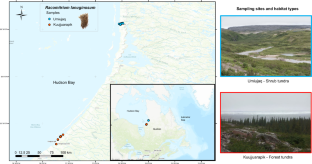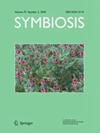在森林-苔原过渡地带,不同数量的细菌驱动广泛分布的苔藓对n2的固定
IF 2
3区 生物学
Q3 MICROBIOLOGY
引用次数: 0
摘要
苔藓植物与影响当地营养收支的细菌保持共生关系。苔藓细菌群落由核心微生物组和从环境来源招募的细菌组成。值得注意的是,共生固氮细菌通过生物固氮对北方生态系统的氮收支做出了贡献。这一过程可能受到重氮营养体丰度和苔藓养分含量的影响。利用加拿大魁北克北部森林冻土带和灌木冻土带中丰富的苔藓Racomitrium lanuginosum,利用细菌16S rRNA和nifH基因的扩增子测序,研究了与生境类型相关的细菌和重氮营养群落,并测试了苔藓核心微生物群是否从土壤细菌群落中招募。利用nifH扩增子和元素分析,考察重氮营养丰度和苔藓养分含量对乙炔还原法测定的固氮活性的影响。不同冻土带类型的苔藓微生物群落具有相似的细菌多样性,但类群丰富程度和微生物相互作用模式存在差异。羊草的核心微生物群由与北方苔藓密切相关的细菌组成,没有明显的土壤补充。显性重氮营养体的相对丰度与乙炔还原率显著相关。相比之下,苔藓养分含量对氮的固定没有显著的驱动作用。变形菌属氮根菌属和红微生物属代表了冻土带中与氮固定率相关的新报道的细菌。我们在森林-苔原过渡带中发现了与苔藓-细菌共生和n2固定有关的关键细菌群,这是一个易受气候变暖影响的变化环境。本文章由计算机程序翻译,如有差异,请以英文原文为准。

Differentially abundant bacteria drive the N2-fixation of a widespread moss in the forest-tundra transition zone
Bryophytes maintain symbiosis with bacteria influencing the local nutrient budget. Moss bacterial communities are composed of a core microbiome and bacteria recruited from environmental sources. Notably, symbiotic N2-fixing bacteria contribute to the N budget in northern ecosystems through biological nitrogen fixation. This process may be affected by the abundance of diazotrophs and moss nutrient content. We used the abundant moss Racomitrium lanuginosum in a forest tundra and shrub tundra in Northern Quebec, Canada, to investigate the bacterial and diazotrophic communities associated with habitat type using amplicon sequencing of the bacterial 16S rRNA and nifH genes and test whether the moss core microbiome has recruitment from the soil bacteria community. The nifH amplicons and element analysis were used to test the effect of diazotrophic abundance and moss nutrient content on N2-fixation activity estimated by acetylene reduction assays. Moss microbial communities between tundra types hosted similar bacterial diversity but differentially abundant groups and characteristic microbial interaction patterns. The core microbiome of R. lanuginosum is composed of bacteria strongly associated with northern mosses with no significant recruitment from the soil. The relative abundances of dominant diazotrophs are significantly correlated with acetylene reduction rates. In contrast, the moss nutrient content did not significantly drive N2-fixation. The proteobacterial genera Azorhizobium and Rhodomicrobium represent newly reported bacteria associated with N2-fixation rates in the tundra. We identified critical bacterial groups related to moss-bacterial symbiosis and N2-fixation in the forest-tundra transition zone, a changing environment susceptible to climate warming.
求助全文
通过发布文献求助,成功后即可免费获取论文全文。
去求助
来源期刊

Symbiosis
生物-微生物学
CiteScore
4.80
自引率
8.00%
发文量
56
审稿时长
>12 weeks
期刊介绍:
Since 1985, Symbiosis publishes original research that contributes to the understanding of symbiotic interactions in a wide range of associations at the molecular, cellular and organismic level. Reviews and short communications on well-known or new symbioses are welcomed as are book reviews and obituaries. This spectrum of papers aims to encourage and enhance interactions among researchers in this rapidly expanding field.
Topics of interest include nutritional interactions; mutual regulatory and morphogenetic effects; structural co-adaptations; interspecific recognition; specificity; ecological adaptations; evolutionary consequences of symbiosis; and methods used for symbiotic research.
 求助内容:
求助内容: 应助结果提醒方式:
应助结果提醒方式:


